Hello, dear readers! Welcome to a world where colors speak, stories breathe, and tradition flows through every brushstroke — the enchanting world of Pattachitra painting of Odisha. This ancient art form isn’t just about painting on cloth; it’s about storytelling, devotion, and heritage coming alive together.
Originating centuries ago in the temple town of Puri, these hand-painted scrolls were once created to narrate mythological tales of Lord Jagannath, Krishna, and other deities. Each painting is a symphony of natural colors, fine detailing, and deep symbolism — all done with patience and heart.
Even today, Pattachitra continues to inspire artists and art lovers across the world, proving that true tradition never fades, it simply evolves with time.
So, let’s unfold the story behind these timeless canvases and discover how every stroke carries the spirit of Odisha.
🏺 History and Origins of Pattachitra Painting
The story of Pattachitra painting begins in the ancient land of Odisha, over a thousand years ago. The word ‘Pattachitra’ comes from two Sanskrit words — ‘Patta’ meaning cloth and ‘Chitra’ meaning picture. Together, it means “painting on cloth.”
This art form is believed to have started around the 12th century, closely linked to the Jagannath Temple of Puri. The temple priests and artists, known as Chitrakars, created these paintings as offerings and souvenirs for devotees of Lord Jagannath, Balabhadra, and Subhadra. When the deities were kept away from public view during rituals, these painted scrolls were displayed to represent them.
The themes of Pattachitra Paintings mostly revolve around Hindu mythology, especially the tales of Lord Krishna, Jagannath, and episodes from the Ramayana and Mahabharata. Each painting tells a story through fine lines, bold colors, and intricate borders.
Over time, the tradition spread from Puri to other parts of Odisha, like Raghurajpur, where families of artists still keep the legacy alive. Despite the passing centuries, the soul of Pattachitra painting remains unchanged — a living art form that connects devotion, storytelling, and heritage through every brushstroke.
🎨 Materials Used in Pattachitra Painting
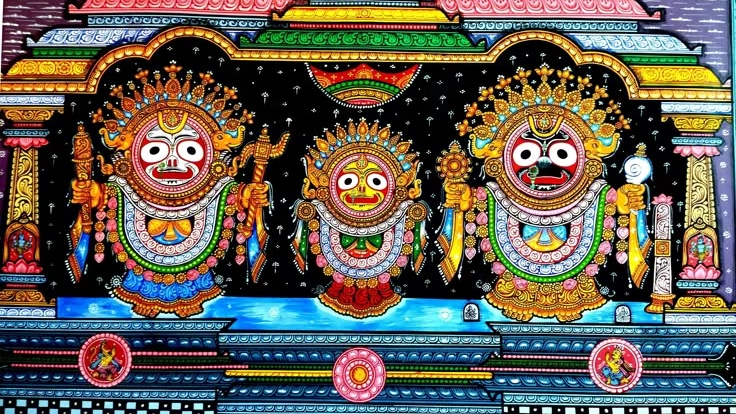
Pattachitra painting is not just a painting—it’s a harmony of nature and devotion. Everything used in creating it comes from the earth itself, keeping the art form sustainable and soulful. Let’s explore what goes into this masterpiece.
🧵 1. The Canvas: The “Patta” or Cloth
- The word Pattachitra comes from two Sanskrit words—Patta (cloth) and Chitra (picture).
- The base material is an old cotton cloth, often reused from household textiles.
- The cloth is carefully washed and dried before being coated to make it strong and smooth.
- Sometimes, artisans use palm leaves (Talapatra Chitra) for a more traditional version.
🪔 2. Natural Adhesives and Coating Materials
- A mixture of chalk powder and tamarind seed paste is applied to the cloth to create a smooth painting surface.
- Tamarind seeds are soaked overnight, boiled, and ground to make a sticky paste that binds the layers together.
- This coating not only strengthens the cloth but also makes it slightly glossy, giving a stone-like texture after polishing.
🌿 3. Natural Colors and Pigments
Pattachitra painters, called Chitrakars, create colors from natural sources around them. Each color has a story:
- White – Made from crushed conch shells, symbolizing purity.
- Black – Derived from lamp soot mixed with oil or water.
- Red – Created from Hingula (a mineral found in Odisha’s mines).
- Yellow – Made using Haritala, a natural yellow stone.
- Green – Extracted from leaves or crushed stones.
- Blue – Derived from indigo or certain berries.
These colors are mixed with water and gum to make them long-lasting and bright.
🖌️ 4. Brushes: Simple Yet Powerful Tools
- Brushes are handmade using keya plant fibers or rat’s hair tied to a bamboo stick.
- The thinness of the brush defines the level of detail. For outlines, a fine-tipped brush is used; for coloring, broader ones are preferred.
- The artist’s steady hand and experience decide the beauty of every stroke.
🪡 Steps of Making Pattachitra Paintings
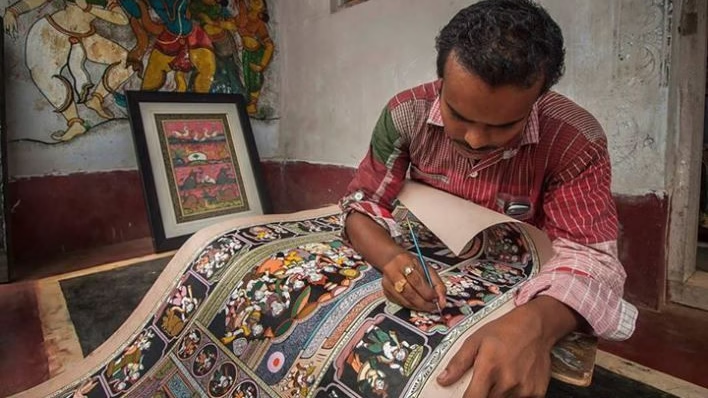
Now that we know what goes into it, let’s walk through how these breathtaking pattachitra paintings are brought to life—step by step.
✨ Step 1: Preparing the Cloth
- Two layers of cotton cloth are glued together with tamarind seed paste and chalk powder.
- Once dried, the surface is rubbed gently with a stone or shell to make it smooth and glossy.
- This prepared canvas is then cut into required sizes.
✍️ Step 2: Outlining the Drawing
- The artist begins by sketching the main figures using light pencil marks or sometimes directly with a brush.
- Common themes include stories from the Ramayana, Mahabharata, and Jagannath Leela (the tales of Lord Jagannath).
- Borders are decorated with detailed floral and geometric designs to frame the artwork beautifully.
🎨 Step 3: Filling in the Colors
- Natural colors are filled in carefully, starting from lighter shades to darker tones.
- The painting follows a strict color code—red background, white and yellow highlights, and black outlines.
- Every color layer is allowed to dry before adding another, ensuring the tones remain vibrant and permanent.
🪶 Step 4: Finishing and Polishing
- Once coloring is complete, the outlines are redrawn to enhance clarity.
- The entire surface is then polished with a soft cloth or conch shell for a glossy finish.
- This gives the painting a luminous, almost enamel-like texture that stands the test of time.
🖼️ Step 5: Drying and Framing
- The finished artwork is dried naturally in the shade (not under direct sunlight) to protect the colors.
- Finally, it is either rolled for storage or framed for display.
- Traditionally, these pattachitra paintings were rolled and taken to villages by artisans who narrated stories using them—a beautiful blend of art and storytelling.
🎨 Symbols and Motifs in Pattachitra Paintings
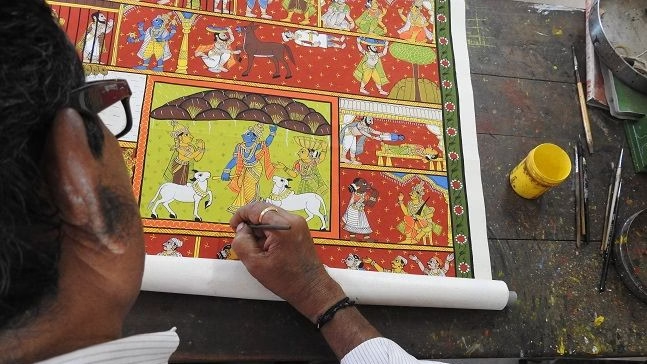
- Pattachitra paintings are not just about color and brush—it’s a language of symbols, each carrying meaning, faith, and emotion.
- Every line, curve, and motif tells a part of a story—whether it’s a scene from Lord Jagannath’s life or a whisper of nature’s rhythm.
- These symbols are deeply rooted in Odia culture, mythology, and temple rituals, making the paintings spiritual as well as decorative.
🕉️ 1. Divine Symbols: The Heart of Pattachitra
- The Chakra (Wheel)
- Symbol of Lord Jagannath’s Sudarshan Chakra, representing time, motion, and protection.
- Seen often behind the deities, it reminds viewers of divine control over the universe.
- Symbol of Lord Jagannath’s Sudarshan Chakra, representing time, motion, and protection.
- The Lotus (Padma)
- Represents purity, beauty, and spiritual awakening.
- Artists use lotus motifs around borders or near gods, adding grace and harmony.
- Represents purity, beauty, and spiritual awakening.
- The Conch (Shankha)
- Sign of prosperity and sacredness in Hindu rituals.
- In Pattachitra, it marks the presence of divine sound and positive energy.
- Sign of prosperity and sacredness in Hindu rituals.
- The Eye Motif
- Inspired by Lord Jagannath’s round, expressive eyes.
- Known as “Nayana,” it symbolizes spiritual vision and awareness.
- Almost every deity in Pattachitra is painted with large, almond-shaped or circular eyes, believed to connect the soul of the painting with the observer.
- Inspired by Lord Jagannath’s round, expressive eyes.
🐚 3. Nature and Animal Motifs: Life in Motion
- Floral Borders and Vines
- Artists paint vines and flowers to symbolize growth, fertility, and continuity of life.
- These detailed borders are unique signatures of Pattachitra style.
- Artists paint vines and flowers to symbolize growth, fertility, and continuity of life.
- Elephants and Lions
- Elephants represent strength, wisdom, and royalty; lions symbolize courage and power.
- These animals often appear near temples or gods, showing their importance as divine companions.
- Elephants represent strength, wisdom, and royalty; lions symbolize courage and power.
- Fish Motif
- A favorite in Odia art—it represents good luck, fertility, and the cycle of life.
- Sometimes, two fish facing each other are drawn to symbolize harmony and union.
- A favorite in Odia art—it represents good luck, fertility, and the cycle of life.
🌿 4. Geometric and Decorative Motifs: Balance and Beauty
- Circle and Mandala Forms
- Circles stand for eternity, wholeness, and the cyclical nature of time.
- Mandala-like patterns often surround deities, symbolizing the cosmic order.
- Circles stand for eternity, wholeness, and the cyclical nature of time.
- Borders (Jhalar or Phoola Jhal)
- Intricate border patterns made of floral or geometric designs that frame the main story.
- These borders not only add beauty but also maintain balance and focus in the composition.
- Intricate border patterns made of floral or geometric designs that frame the main story.
🕊️ 5. Cultural Motifs and Human Emotions
- Dancing Figures and Musicians
- Represent the joy of festivals and devotion.
- Capture everyday emotions—love, celebration, and community life.
- Represent the joy of festivals and devotion.
- Temple Arches and Pillars
- Reflect the architectural beauty of Odisha’s temples.
- They create a divine backdrop for the gods and goddesses depicted.
- Reflect the architectural beauty of Odisha’s temples.
✨ 6. The Essence Behind Every Motif
- Every motif in Pattachitra is painted with purpose—none is random or decorative alone.
- The symbols create a bridge between the divine and human worlds, expressing devotion through color and form.
- Through centuries, these motifs have remained constant, reminding us that art is not just seen—it’s felt, believed, and lived.
👩🎨 Artists and Local Communities Behind the Craft
The word Chitrakar means “painter” in Sanskrit. These are the traditional artists who have preserved the art of Pattachitra for more than a thousand years.
Most of them live in Raghurajpur, a heritage village near Puri in Odisha, known as the heartland of Pattachitra. Every house here is an artist’s studio, filled with brushes, colors, and paintings hanging to dry.
- Family Tradition of Art
- Art runs in the blood of these families. Skills are passed down through generations, from parents to children.
- Children learn to draw before they can even write letters, starting with simple motifs like flowers and leaves.
- Art runs in the blood of these families. Skills are passed down through generations, from parents to children.
🎨 1. The Role of Women in the Craft
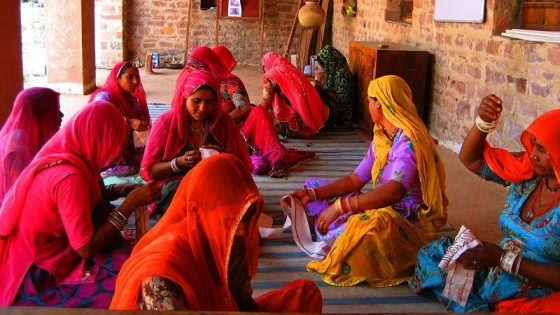
- Behind Every Masterpiece
- Though men traditionally draw the main outlines, women play an equally important role.
- They prepare the canvas, mix colors from natural sources like stones, shells, and plants, and paint delicate backgrounds and borders.
- Many women are now emerging as independent Pattachitra artists, blending tradition with modern stories and themes.
- Though men traditionally draw the main outlines, women play an equally important role.
- Teamwork in Pattachitra Paintings
- Making one painting often involves several members of a family. Each artist contributes — one sketches, another colors, and someone else adds finishing touches and varnish.
- This teamwork gives every painting a sense of unity and shared creativity.
- Making one painting often involves several members of a family. Each artist contributes — one sketches, another colors, and someone else adds finishing touches and varnish.
🌾 2. Life Around the Craft
- Daily Routine of Artists
- The day begins early in Raghurajpur. Artists offer prayers before starting work, believing their art is a form of devotion to Lord Jagannath.
- They work for hours in natural light, creating detailed paintings on cloth, palm leaves, or even coconut shells.
- The day begins early in Raghurajpur. Artists offer prayers before starting work, believing their art is a form of devotion to Lord Jagannath.
- Art as Livelihood
- Besides temple work and local fairs, many artisans now sell their art globally through exhibitions and online platforms.
- Government and NGOs also help organize craft fairs, training programs, and marketing support for young artists.
- Besides temple work and local fairs, many artisans now sell their art globally through exhibitions and online platforms.
🌟 3. A Living Legacy
- Art Beyond Generations
- The Chitrakar community doesn’t just paint—they preserve Odisha’s spiritual and cultural heartbeat.
- Every stroke of their brush tells a story, keeping alive the traditions of devotion, storytelling, and craftsmanship.
- The Chitrakar community doesn’t just paint—they preserve Odisha’s spiritual and cultural heartbeat.
📊 Statistics and Modern Reach on Pattachitra Paintings
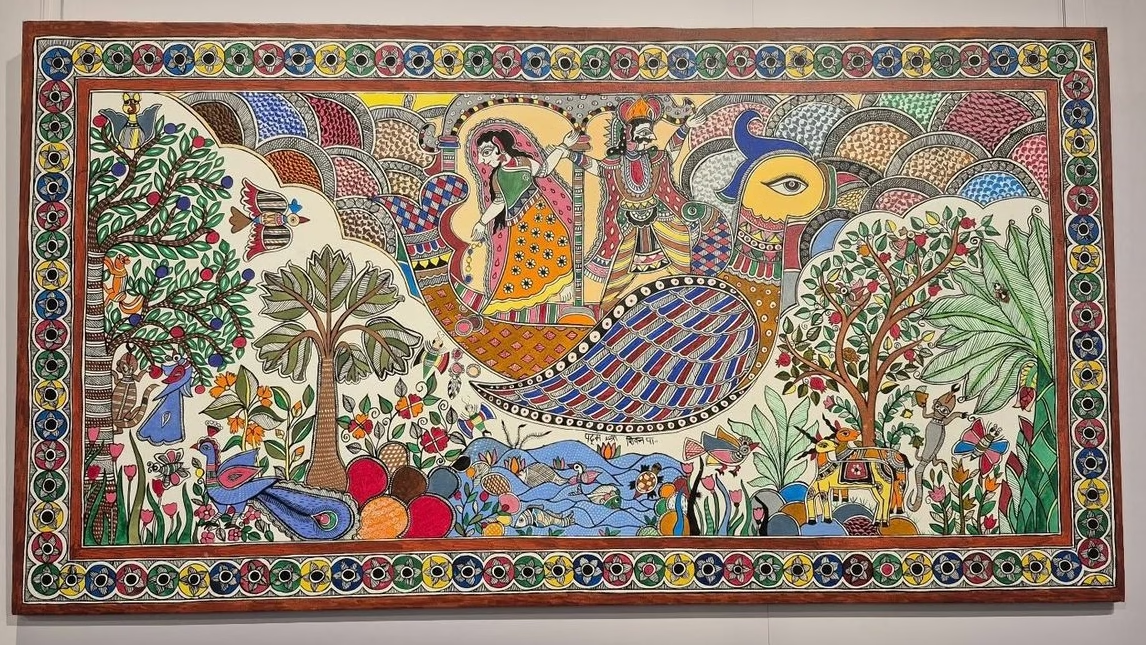
The journey of Pattachitra has gracefully moved from ancient temple walls to global art galleries. Once a sacred art form made only for devotional purposes, it now travels beyond Odisha — into homes, exhibitions, and online platforms across the world. Let’s explore its modern presence and real-world impact through numbers and narratives.
🧑🎨 1. Artisans and Production Clusters
- Major Centers: The most prominent hubs are Raghurajpur, Puri, Dandashahi, and Chandanpur in Odisha.
- Number of Artisans:
- Over 1,200 traditional artisans in and around Raghurajpur village alone are actively engaged in creating Pattachitra and related crafts.
- Across Odisha, around 2,500–3,000 families depend on this art form for their livelihood.
- Over 1,200 traditional artisans in and around Raghurajpur village alone are actively engaged in creating Pattachitra and related crafts.
- Generational Skill:
- Nearly 80% of artists in these clusters inherit the craft from their ancestors, learning from childhood through close observation and practice.
- Nearly 80% of artists in these clusters inherit the craft from their ancestors, learning from childhood through close observation and practice.
💰 2. Economic Contribution and Livelihood
- Local Economy: Pattachitra Paintings supports entire villages through workshops, cooperative societies, and cultural tourism.
- Average Income:
- Skilled artisans can earn between ₹10,000 to ₹30,000 per month, depending on their expertise and the scale of their work.
- Skilled artisans can earn between ₹10,000 to ₹30,000 per month, depending on their expertise and the scale of their work.
- Export and Sales:
- According to Odisha’s Handicrafts Department reports, Pattachitra contributes nearly 15–20% of the state’s total handicraft export revenue.
- These paintings are now sold on online platforms like Craftsvilla, Amazon Karigar, and Tribes India, expanding their market reach globally.
- According to Odisha’s Handicrafts Department reports, Pattachitra contributes nearly 15–20% of the state’s total handicraft export revenue.
🌍 3. Global Recognition and Exhibitions
- International Exhibitions: Pattachitra artworks have been showcased in London, Paris, New York, and Tokyo, representing Indian folk art on global stages.
- UNESCO Recognition: Raghurajpur, the heritage crafts village, is recognized as a UNESCO Heritage Craft Village, drawing thousands of tourists annually.
- Cultural Exchange Programs: Artists are invited to workshops abroad, where they conduct live painting sessions, teaching traditional techniques to international students.
📈 4. Modern Adaptations and Digital Revival
- New Mediums: Beyond cloth and palm leaves, Pattachitra motifs now appear on sarees, home décor, stationery, and jewelry.
- Digital Presence:
- Artisans have started using Instagram, Facebook, and Etsy to display and sell their work directly.
- Virtual exhibitions and YouTube tutorials are helping younger artists reach audiences beyond borders.
- Artisans have started using Instagram, Facebook, and Etsy to display and sell their work directly.
- Government Support: Schemes like GI tagging (Geographical Indication) and handicraft fairs organized by the Odisha State Handicrafts Corporation promote and preserve the art form.
🌿 Preservation and Future of Pattachitra Paintings
- Family Lineage of Artists: Most Pattachitra painters, known as Chitrakars, continue their family tradition, teaching children the age-old techniques at home.
- Cultural Training Centers: Art schools and local workshops in Raghurajpur and Puri train young artists to master brushwork, natural color-making, and story composition.
- Temple Preservation: Temples of Jagannath in Puri still commission Pattachitra scrolls and ritual paintings, ensuring cultural continuity.
💡 Modern Support and Government Initiatives
- GI Tag Recognition: The Geographical Indication (GI) tag protects the originality of Odisha’s Pattachitra, giving artists global identity and fair trade benefits.
- Handicraft Exhibitions & E-Commerce: Government fairs, online platforms, and craft markets connect rural artisans with worldwide buyers, creating stable incomes.
- Collaborations and Innovations: Artists now paint on modern items like lamps, trays, and apparel, blending tradition with contemporary tastes.
🎯 Conclusion
So, folks, the Pattachitra Paintings of Odisha stand as a living bridge between mythology, devotion, and craftsmanship. Each brushstroke carries centuries of tradition, echoing the devotion of artisans who transform natural colors and handmade cloth into sacred storytelling.
Beyond their visual beauty, these paintings preserve the spiritual and cultural soul of Odisha, celebrating harmony between art and faith. As Pattachitra paintings continues to evolve—from temple walls to modern galleries—it reminds us that true art never fades.
Also read: Warli Pattern Ceramic Mugs

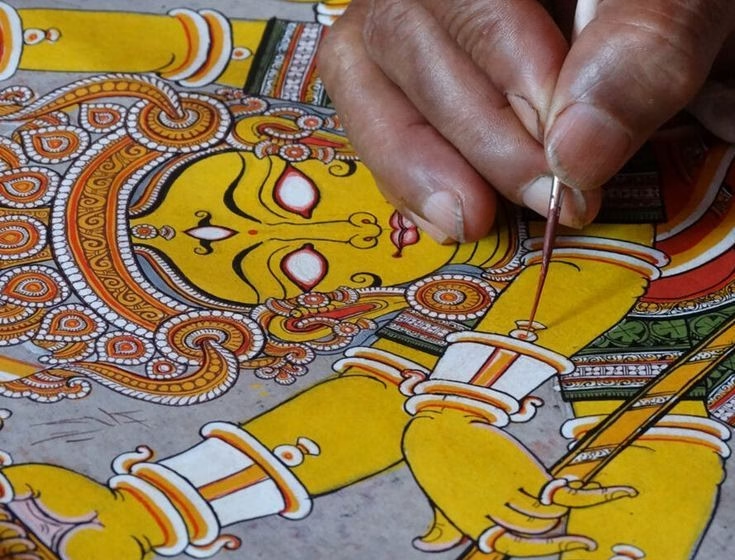
Leave a Reply